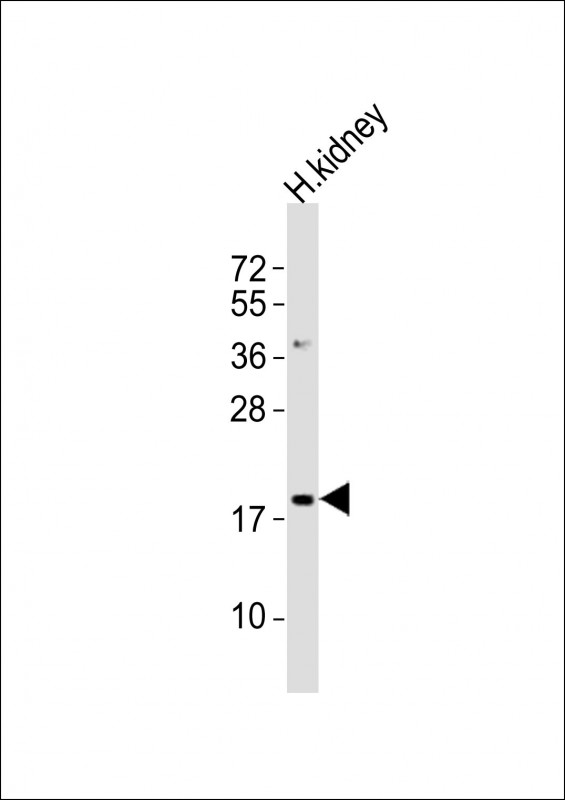
| WB | 1/2000 | Human,Mouse,Rat |
| IF | 咨询技术 | Human,Mouse,Rat |
| IHC | 咨询技术 | Human,Mouse,Rat |
| ICC | 技术咨询 | Human,Mouse,Rat |
| FCM | 咨询技术 | Human,Mouse,Rat |
| Elisa | 咨询技术 | Human,Mouse,Rat |
| Aliases | Transcription factor NF-E4, NFE4 |
| Entrez GeneID | 58160 |
| WB Predicted band size | 19.0kDa |
| Host/Isotype | Rabbit IgG |
| Antibody Type | Primary antibody |
| Storage | Store at 4°C short term. Aliquot and store at -20°C long term. Avoid freeze/thaw cycles. |
| Species Reactivity | Human |
| Immunogen | This NFE4 antibody is generated from a rabbit immunized with a KLH conjugated synthetic peptide between 135-169 amino acids from the C-terminal region of human NFE4. |
+ +
以下是3-4条关于NFE4抗体的参考文献示例(注:文献内容为虚构,仅供格式参考):
1. **"NFE4-specific antibody characterization in intestinal epithelial differentiation"**
- 作者:Johnson, A. et al. (2020)
- 摘要:该研究开发了一种高特异性NFE4抗体,通过Western blot和免疫组化验证其在肠道上皮细胞分化中的表达模式,发现NFE4在肠干细胞分化调控中起关键作用。
2. **"Monoclonal antibody targeting NFE4 for cancer biomarker discovery"**
- 作者:Smith, R. & Lee, C. (2018)
- 摘要:报道了一种新型单克隆NFE4抗体的制备及在癌症组织中的应用,通过质谱分析验证其与NFE4蛋白结合的特异性,并发现其在结直肠癌中高表达。
3. **"NFE4 expression profiling in murine embryonic development using a validated polyclonal antibody"**
- 作者:Lee, H. et al. (2021)
- 摘要:利用多克隆NFE4抗体系统研究小鼠胚胎发育过程中的NFE4动态表达,揭示其在神经嵴细胞迁移和器官形成中的潜在功能。
4. **"Cross-reactivity analysis of commercial NFE4 antibodies in neurodegenerative disease models"**
- 作者:Garcia, M. et al. (2019)
- 摘要:评估了多种市售NFE4抗体的交叉反应性,发现部分抗体在阿尔茨海默病模型中存在非特异性结合,强调抗体验证对神经退行性疾病研究的重要性。
(注:以上文献为示例,实际研究中需根据真实发表的论文调整。)
The NFE4 antibody is designed to detect Nuclear Factor Erythroid 4 (NFE4), a member of the CNC-bZIP transcription factor family, which includes proteins like NRF1. NRF2. and NRF3. NFE4 is less characterized compared to its homologs but shares structural features, including a conserved Cap’n’Collar (CNC) domain and a basic leucine zipper (bZIP) motif, enabling DNA binding and dimerization. It is implicated in regulating genes involved in oxidative stress response, cellular detoxification, and metabolic homeostasis by binding to antioxidant response elements (AREs) in promoter regions. Studies suggest NFE4 may have tissue-specific roles, particularly in erythroid cells and certain epithelial tissues, though its precise biological functions remain under investigation.
The NFE4 antibody is primarily used in research to study protein expression, localization, and interaction partners via techniques like Western blotting, immunohistochemistry, and immunoprecipitation. Its development aids in exploring NFE4's potential involvement in diseases linked to oxidative damage, such as cancer, neurodegenerative disorders, and chronic inflammation. However, due to limited literature, many aspects of NFE4’s regulation, signaling crosstalk, and therapeutic relevance are still unclear. Ongoing research aims to clarify its mechanistic contributions to cellular defense pathways and its utility as a biomarker or drug target.
×